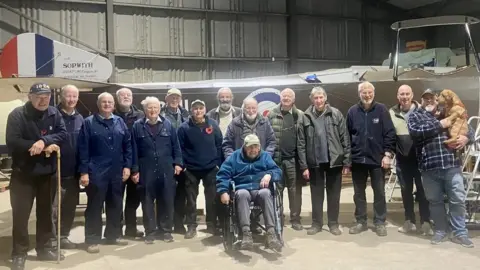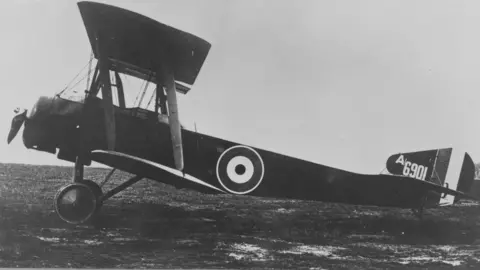The men who spent 20 years building a fighter plane
 BBC
BBCMore than 20 years ago, a group of retired men had the idea of building a replica World War One aircraft - from scratch.
But the aviation enthusiasts didn't just want it to be a museum piece, the plan was for it to fly as well.
It was an ambitious project but the Aviation Preservation Society of Scotland (APSS), based in East Lothian, believe they may finally be close to getting their home-made Sopwith 1½ Strutter in the air.
Retired engineer Len Hart has been part of the project for well over a decade.
The 73-year-old said: "At the beginning we just used to come once a week and work but as it's been taking shape you can actually see that it's going to fly."
Len is one of more than 40 APSS members, aged between 64 and 96.
 APSS
APSSHe is proud of the enormous effort they have put in over the years.
"Every single piece you see is hand-made - filed and cut," Len said.
"There's hundreds of brackets and I've made many of them. So it's an immense project."
Most of the volunteers have engineering backgrounds and were delighted to take on the task in their retirement.
Evan Pole, 85, has been involved since the beginning and he said it gave him a purpose.
"It was something that kept your hands and brain going - something to get up for in the morning and say 'Right, I'm going to make whatever it is they had in mind that day'.
 APSS
APSS"Beside the work, there's also the social element," he said.
"You're working with other like-minded old guys.
"We drank a lot of tea and it was a godsend to me and a lot of people who had retired."
The Sopwith 1½ Strutter was the first British two-seater fighter plane to have a machine-gun synchronised with its propeller.
It came into service in 1916 and helped to counter the German Fokkers which had dominated the skies during the early part of the war.
In Scotland it became useful as a reconnaissance plane to protect the Forth coastline and Rosyth dockyard against German zeppelins.
The team followed the original plans for the aircraft in painstaking detail and say it is the closest thing to an original, working World War One aircraft in Scotland.
APSS chairman Mike Harper said the aircraft's links to Edinburgh, the Forth and East Lothian made it the perfect choice for them to recreate.
He said: "It was an aircraft used in the local area but more importantly this particular aircraft was used for the first successful take-offs and landings from a flat-top ship - an aircraft carrier.
"The aircraft carrier was actually first used here on the Firth of Forth in 1918."
The team has a wide range of skills and decades of experience but now they want younger people to get involved, so they can pass on their knowledge.
 Getty Images
Getty ImagesAPSS secretary Lindsay Lees said: "We're discussing with various colleges and schools to see if we can offer courses to bring people in, give them a bit of work experience.
"There's obviously a lot of skills going in to building this aircraft in terms of woodworking, metal working, planning and all that kind of stuff.
"We think we can offer the local community a bit of expertise if that's the sort of thing kids want to do when they leave school."
Light aircraft inspector Tim Rayner has been a volunteer with the project since the start, and it is his job to check everything is ready before it takes to the skies.
He said: "You can't go out and buy one of these, you've got to have it made, and the guys have put in 23 years so far.
"It's a huge undertaking and it's their pride and joy.
"Once we've got to the stage where we're comfortable that it's safe to fly I know I'll have some passengers to take flying as all of them will want to go flying in it."
 APSS
APSSHe added: "It is such a significant aircraft because there will be only three of these flying in the world that we know of. I want it to be perfect."
Over the years, the APSS has seen a number of its members pass away, never getting to see the final product.
In their honour, a plaque with their names on is going to be put on the passenger seat of the plane for when it finally takes off.
In preparation for that day, the wings of the plane have been packed for traveling to a nearby airfield where it will be assembled and checked.
If all goes to plan, the replica Sopwith Strutter should be in the air at some time next year.
But there's no time for the team to put their feet up.
They have already started work on their next replica plane.
